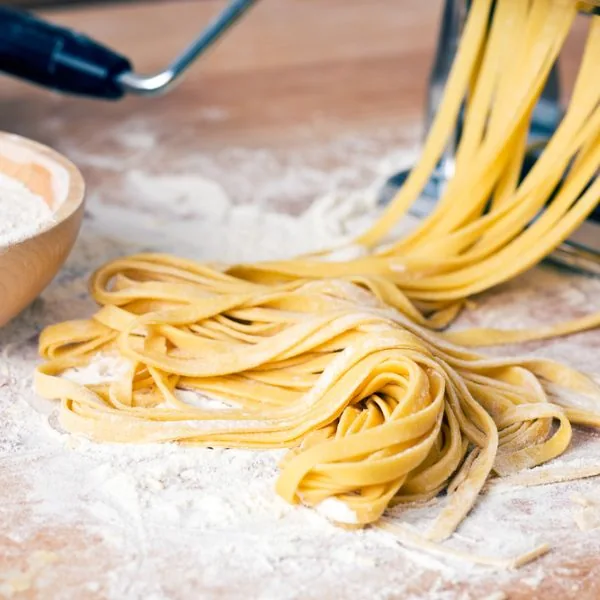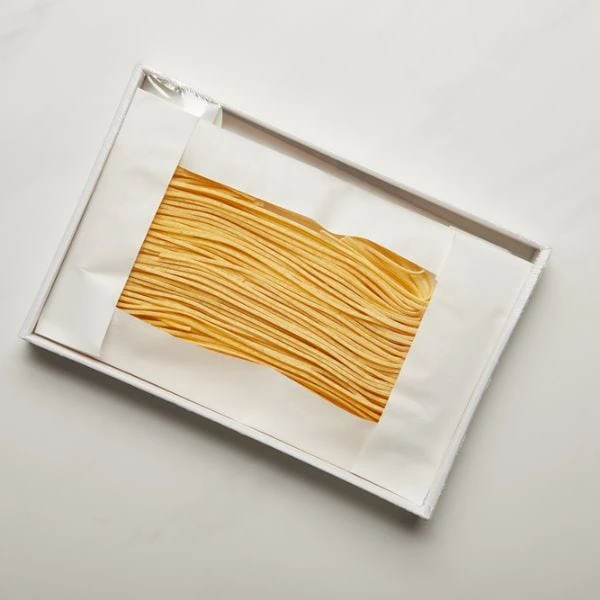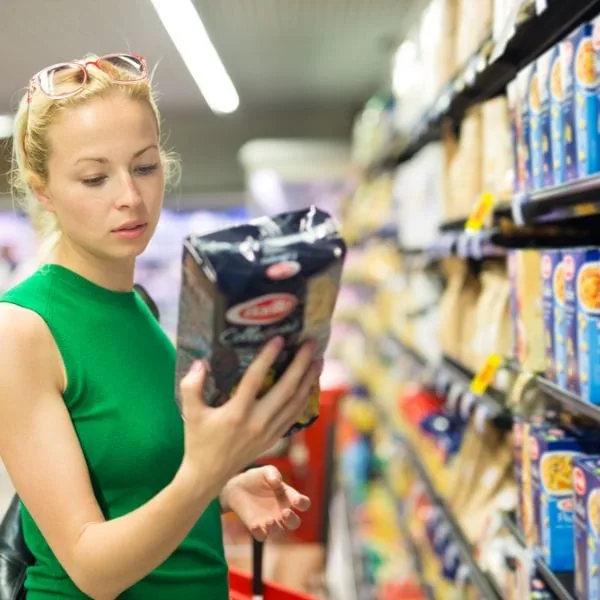When you feel like a little comfort food, pasta really hits the spot. So, is pasta vegan by ‘default’, or is it a food that you need to be careful with when buying at the store or in a restaurant?
With the exception of lasagna sheets, most dry pasta that you get at the store such as spaghetti, linguini, fusilli, penne, and macaroni will all be vegan. They’re usually just made of wheat and water, although you should still check the ingredients just in case!
There’s a little more to it, of course, so today we’re going to talk about pasta and how to be 100% that what you are getting is vegan. Don’t worry – this is actually one of the easiest foods to check, but there are definitely a few things to watch for and we’ll tell you all about them!
How pasta is made

When commercial dry pasta is made, it’s usually just a combination of durum semolina and water. Semolina is just a term for coarse flour that is ground from the endosperm of durum wheat and so most pastas are going to be perfectly vegan as they are – just wheat flour and water.
Typically iron and vitamin B are added to the flour so that it’s a little more nutritious and once that is done, then it gets shipped off to the pasta manufacturing plant.
Of course, once it gets there, additional ingredients may be added and this is where things can get a little trickier. Most of the ingredients won’t be a problem for vegans. Common additions are vegetable juices for flavor, so there may be spinach, tomato, carrot, or beet juice added, and with some brands, there may be added basil, thyme, or garlic.
This is the point when eggs may be added, although this is usually just for egg noodles, and if the noodles are dyed then this might be a problem as well, as squid ink is often used in some of the fancier brands.
So, as you can see, the odds are very much in your favor as a vegan when it comes to pasta – at its most basic it’s just semolina and water and that’s about as vegan a recipe as it gets!
What about fresh pasta at restaurants or grocery stores?
Fresh pasta is a definite ‘you’ll need to ask’ scenario if you are in a restaurant, although with stores there should be an ingredient list that you can check. Many restaurants will be making their pasta with a flour and egg recipe, but there is always a chance that they are using dry wheat pasta so be sure to ask for more information.
Pasta doesn’t have to be made with eggs, as some authentic recipes will be just flour and water or oils may be added instead of eggs. Just be sure to double-check – it never hurts to ask and pasta recipes can vary a lot from chef to chef, so it’s the safest course of action.
Checking the ingredients – What to look for

Once you know what to look for, it won’t matter if you’re in a store with no vegan-specific brands, so in this section, we’ll give you a quick crash course in ingredients. We’ll divide them up into ‘definitely vegan’, ‘maybe vegan’, and ‘Not vegan at ALL’ ingredients so that the next time you look at a label you’ll be able to choose a vegan option every time!
With that, let’s get started with those ingredients:
Definitely vegan ingredients
This is going to be the easiest to remember, as pasta is typically made from durum semolina or you might even see ‘wheat flour’ listed. Beyond this, in the most basic pasta, you might also see salt and water as the other ingredients, and in a case like this, you can bring that pasta home with confidence.
You’re not out of the woods yet, however, as the ‘maybe’ ingredients are where things get a little more tricky.
‘Maybe’ vegan ingredients
These ingredients are probably going to be the most annoying for you when you spot them, as they ‘might’ be vegan and they might well NOT. Here is the troublesome trip that you should look for on the labeling:
- Calcium phosphate
- Iron lactate
- Monoglycerides
- Dyes
Calcium Phosphate
Calcium phosphate is the first ‘maybe’, but unfortunately in MOST cases, it’s an ingredient to avoid. That’s because the calcium part of the equation usually comes from animal products like bone or seashells and there are a lot of bone-derived phosphates.
That said, at its most basic, it’s a calcium salt, so there ARE vegan versions, but this is definitely a case where you’ll need to contact the manufacturer in order to be sure.
Iron lactate
While iron lactate –also called ‘ferrous lactate’– sounds like a dairy product, it’s actually a salt and it is prepared by utilizing lactic acid. Now, in most cases, if the iron lactate is sourced from the United States, then it will be prepared using a lactic acid that is derived from a fermentation of corn or beet sugar.
Keep in mind that we said ‘in most cases – some U.S. sourced iron lactate and most iron lactate sourced from other countries will definitely NOT be vegan. That’s because lactic acid is also obtained from fermented dairy products, and you’re not going to have a way to tell which is which from the labeling alone.
If you see iron lactate in the ingredients, then you’ll need to contact the manufacturer of the pasta in order to determine how their calcium phosphate is made or simply go with a vegan-specific brand.
Monoglycerides
Monoglycerides are another ‘maybe’ ingredient that could really go either way. At their core, they are just glycerol and a fatty acid chain, but the problem is that they may be sourced from animal fats or from soybeans – and if it’s not made clear on the package, then sadly you will need to check!
Dyes
With dyes, the good news is that almost every color derived from natural food coloring is going to be 100% vegan – with two notable exceptions to that rule. ‘Carmine’, which is a red shade that you probably won’t see unless it’s a novelty kid’s pasta, is made from crushed beetles.
The one you really gotta watch out for is black-dyed pasta, which may accomplish that cool color by means of squid ink. The squid ink SHOULD be on the ingredients – it’s usually considered fancy so they’ve no reason to be vague – but get used to looking for it as it’s an easy one to miss if you don’t.
‘Not vegan at all’ ingredients
Most of these ingredients are items that you already look for, but just to be clear let’s take a look at some no-no ingredients that you might well see on the pasta package. Thankfully, with pasta, it’s a pretty small list:
- Any mention of ‘egg’ (egg whites, yokes, and albumin)
- Milk or milk powder
- Whey
These are pretty basic – eggs, milk, and whey (which is derived from milk), so when you check the ingredients label you won’t have to worry too much. As we said in the beginning of the article, pasta is one of those lucky foods that vegans won’t have to spend an era analyzing ingredients for and we have to say, isn’t that nice?
Don’t skip the ingredients, of course, but be sure to enjoy this little moment of zen, courtesy of an age-old recipe that was mostly vegan to begin with!
Finding vegan pasta at your local grocer

If you are in a hurry or shopping for someone and want to absolutely avoid any possible goofs on procuring vegan pasta, then there are a few brands that you can look for that will save you a little time and stress. Here are the brands, and we’ll tell you a little about each in the sections to follow:
- Banza
- Barilla
- Creamette
- De Cecco
- San Giorgio
Banza
Banza is all about vegan and gluten-free offerings and you can find favorites like Penne, Bucatini, and Rotini; They even have a vegan mac and cheese! Pizza kits with chickpeas are also part of their product line, and we’re really just touching the tip of the iceberg here. Look for the next time that you’re at the store and if you’re looking for new recipes, Banza has a few right here that you can check out and enjoy at home!
While you’re there, if you can’t find Banza at your store, check their ‘where to buy’ section and they should help you find them locally – they’re worth it!
Barilla
You know the name and you’ve probably eaten this pasta at some time – we mean Barilla, of course! This famous brand has quite a lot of vegan options and also gluten-free ones as well. In fact, if you’re looking for some great pasta recipes then you can check Barilla directly at this link.
You’ll see lots of yummy vegan recipes there to put your Barilla pasta to good use, so be sure to take a peek when you’re feeling puckish – you’ll be happy that you did!
Creamette
Avoid their egg noodles, but be sure to take a look at Creamette’s dry pasta and you find a huge assortment of ready-to-cook vegan pasta. They have tri-color varieties, elbow macaroni, and even vegan ‘quick cook’ type pasta that can save you time. Check them out the next time that you visit the store and you’ll see for yourself – vegan pasta really isn’t that hard to find at all!
De Cecco
You’ll want to stick with the blue boxes, as De Cecco offers egg pasta as well, but with their blue-cox varieties, you’ve got a wide range of vegan pasta ready to take home and cook up. Double Check the ingredients, of course, but MOST of their offerings are going to be vegan, and as far as those ‘egg pasta’ offerings, you can avoid them easily because they’re bright yellow!
San Giorgio
A brand you’ve probably seen in the store already, San Giorgio has some vegan-specific offerings that you can look for and eat with confidence. You can find things like over-ready lasagna noodles, manicotti, quick-cook pasta, and more.
Take a closer look at the San Giorgio the next time you’re at the grocer and you’ll see for yourself – they’re definitely looking out for their vegan customers!
Making your own homemade vegan pasta – only 3 ingredients needed!
One of the best ways to ensure that you’re getting 100% vegan fare is to make some vegan pasta on your own. If you like to cook, it’s also a great excuse to whip something special up and we’ve found a recipe that we think you’re going to love.
This recipe comes from Gemma Stafford and BiggerBolderBaking and gives you a great pasta that tastes wonderful on its own or that you can use as a base for your own kitchen wizardry. Here’s what you’ll need:
- 3 cups of all-purpose flour
- ¾ cup water
- 2 tbsp of olive oil
- In a small container, mix your water and your oil together with a whisk and put it to the side.
- Pour your flour out on a large, clean surface, making a large indention or ‘well’ in the center of the flour’s mass
- Start adding your water into your center ‘well’, gently pushing your flour in, and keep doing this until all of the liquid has been absorbed. You can add a small amount of extra water if needed but try to avoid this for now and simply push the sides together to make a rough ball of dough.
- Knead it for approximately 5 minutes to smooth it up nicely and if it still seems too dry, then give it a stingy ‘splash’ of water and smooth it up a little more. We should be able to make the dough into a nice, smooth ball at this point.
- Wrap the pasta dough ball into some plastic wrap as tightly as you can and put it into the fridge for a minimum of 30 minutes time (but longer is fine). This will help the gluten to develop before we cut and shape the pasta properly.
- Remove the dough from your fridge after it’s had time to settle and separate it into 4 equal pieces. Cover these up for now and prepare a flat sheet as a working surface by sprinkling it with flour, and once you’ve done this then take the first dough ball and put it there.
- Give that dough ball a working over with your rolling pin so that you’ve made a paper-thin sheet of dough on the surface. Cut these to the size that you like and then sprinkle them with a little flour and repeat for the remaining pieces of dough.
- Cook it up now by boiling it for 2 minutes until soft and floating up to the surface or you can store it away in a sealed container to cook another time. This pasta will stay fresh for 3 days in your refrigerator or up to 8 weeks in your freezer! Congratulations – you’ve just made your own homemade vegan pasta!
FAQs
We’ve just about run out of time for today but before we go, we’ve collected a few frequently asked questions on the subject of vegan pasta that we get asked quite often. Let’s take a look at what people are asking about this culinary classic comfort food!
Does vegan pasta taste bad?
It’s funny, but some people make a face when you mention ‘vegan’ anything, and with the exception of egg pasta, it has pretty much ALWAYS been a vegan pasta dish.
So, the correct answer to ‘Does vegan pasta taste bad?’ would be ‘Well, do you like regular pasta?’. Remember, commercial pasta that we eat every day is semolina flour and water – sometimes with oil, herbs, or natural vegetable juices.
In the case of pasta, non-vegan varieties are actually the exception, NOT the norm.
How is vegan pasta different?
Since vegan pasta is the ‘standard’ pasta being eaten around the world, the distinction is that it has had nothing animal-based added to it. Non-vegan pasta contains obviously animal-derived ingredients such as milk, eggs, or whey, or ‘maybe’ ingredients such as iron lactate, monoglycerides, or calcium phosphate.
In the case of the ‘maybe’ ingredients they might still be vegan, but you’ll need to check where they are sourced and their specific method of manufacture.
Is pasta sauce vegan-friendly?
As long as it doesn’t contain cream or added meats, then your chances are very good that it is a vegan-friendly sauce. Check the ingredients for egg, milk, and meat and if you don’t see these, then look for calcium phosphate, monoglycerides, and iron lactate or simply go with an all-vegan brand – these days sensible companies cater to vegan needs and can help to take the stress out of shopping for a good, wholesome sauce.
Does vegan pasta have fewer calories?
Sadly, this is one area where you might be disappointed, but we told you that vegan pasta is the NORM, not the exception. Vegan pasta is just pasta and even though it is wheat, it’s going to have roughly the same caloric content and carbs as white flour-based pasta, so this favorite food still falls into the ‘enjoy in moderation’ category.
Some closing words
Today we’ve answered the question ‘Is pasta vegan?’ and the answer is ‘in most cases, yes, but there are exceptions’. The dried pasta that you get at the most is almost always vegan, with the exceptions of lasagna sheets and a few of the fancier brands that may add egg, milk, or other questionable ingredients.
Thankfully, most of them are made of durum semolina wheat flour and water, possibly with added vegetable juices and the occasional appearance of garlic, basil, or thyme. So, just be sure to check the ingredients on your own and it should be a piece of cake to find a nice, vegan pasta that you can eat with confidence.
It’s one of those rare foods that is a delight to pick out at the store, since it’s pretty much always been vegan anyways! Thanks so much for reading and we hope to see you again very soon!










David learned to cook at an early age after his mother told him that he couldn't live on pizza forever, Dave uses his modest kitchen skills to recreate sorely-missed recipes from home and to occasionally make new favorite ones from places he is visiting.